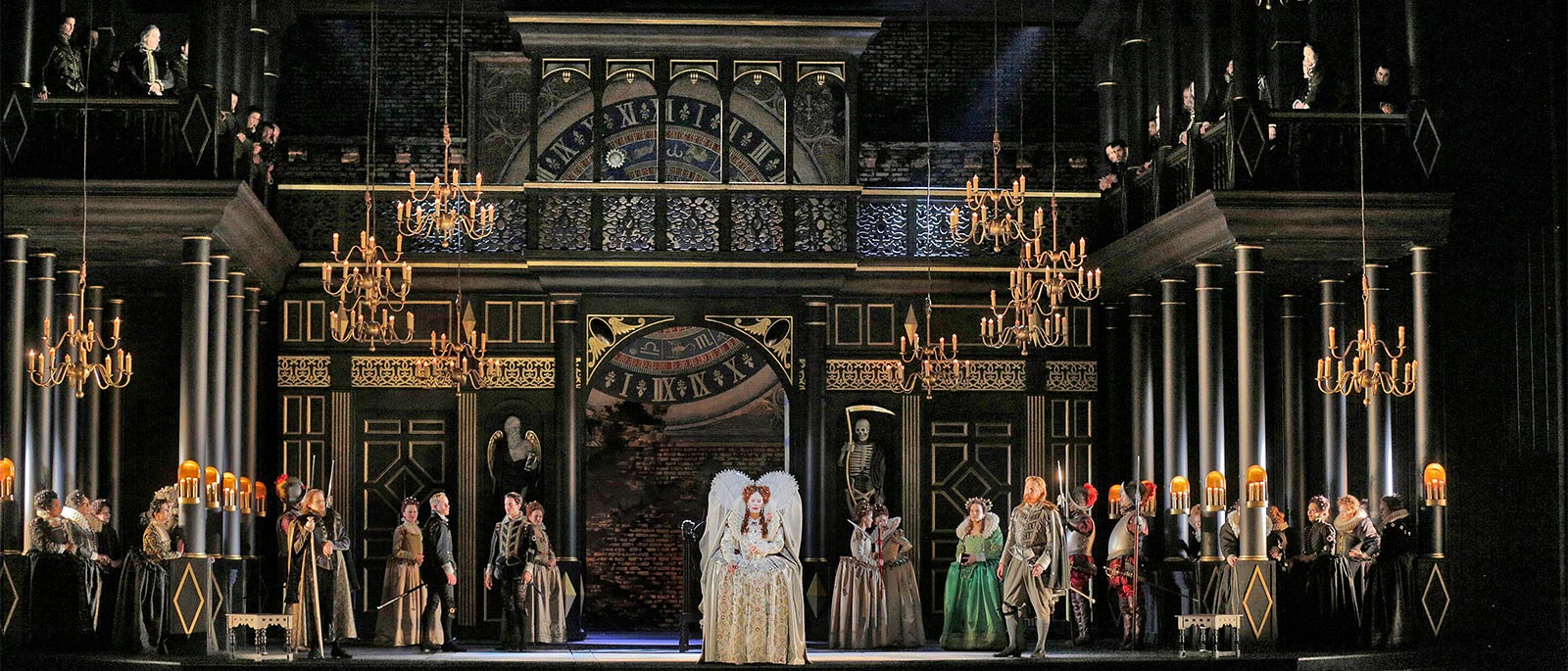MET NEWS, DONIZETTI´S TUDOR QUEENS, ARTICLE

Donizetti’s Tudor Queens at the Met
By Peter Clark
Donizetti’s operas based on the lives of three queens of England’s Tudor dynasty only had their Met premieres in the last ten years. Since Anna Bolena, Maria Stuarda, and Roberto Devereux are widely considered to be some of the Italian composer’s best works musically and dramatically, one might wonder why the Met was so late in staging them.
In the early decades of the Met’s history, only a handful of Donizetti’s operas still held the stage. Their heyday had been earlier in the 19th century, but by 1883 when the Met opened, the Italian bel canto style had become outmoded. Lucia di Lammermoor continued to serve as a vehicle for famous prima donnas, and around the turn of the 20th century, a few other Donizetti works entered the Met’s repertory. Three of his comic operas gained a permanent foothold, but Lucia remained the only one of his many tragic pieces to have a consistent place on the company’s schedule.
Then, in the mid-20th century, Donizetti’s operas, along with those of other Italian bel canto composers such as Rossini and Bellini, gained renewed attention in the opera world. Chiefly, this was due to the advent of a new star soprano, Maria Callas, whose extraordinary vocal and dramatic attributes brought the forgotten old scores to life. Rudolf Bing, the Met’s general manager, was aware of Callas’s exceptional talent from the time he took over the company in 1950 and immediately began communicating offers to her about possible roles she could sing at the Met. But Bing wanted to incorporate her performances into the Met’s repertory system, so his suggestions were always for standard roles like Aida, Tosca, Violetta, Norma, and Lucia (his only unusual suggestion was that she sing the Queen of the Night in Die Zauberflöte). Meanwhile, at La Scala and elsewhere in Italy, Callas was the centerpiece of rare operas revived in handsome productions mounted especially for her. Along with works by Spontini, Gluck, Cherubini, Rossini, and Bellini, La Scala presented a splashy new production of Donizetti’s Anna Bolena starring Callas in the title role (pictured above). The 1957 premiere was one of the diva’s greatest triumphs and proof that at least one of Donizetti’s Tudor queens had been overlooked for too long.
Back at the Met, however, Bing continued to offer Callas only the tried and true, with the exception of Verdi’s Macbeth, which he wanted her to alternate in repertory with existing productions of La Traviata, Tosca, or Lucia. Like many of his generation, Bing generally held the bel canto operas in low regard and was reticent to stage a rarity like Anna Bolena, which would be hard to revive in future seasons when Callas wasn’t available. In the end, Callas’s Met appearances were limited to only four core repertory operas, Norma, Tosca, Lucia di Lammermoor, and La Traviata.
Yet Callas had started a trend with the revival of the long abandoned bel canto repertory, and the movement continued to grow even as her own career wound down. Her successors, Joan Sutherland, Montserrat Caballé, and Beverly Sills, accelerated the bel canto revival and brought two more Tudor queens to the fore. In 1965, Caballé sang Roberto Devereux in concert at Carnegie Hall, then went on to staged performances in Europe and elsewhere to great acclaim. Both Caballé and Sutherland triumphed in the title role of Maria Stuarda in the early 1970s, and later in their careers added Anna Bolena. Yet none of these performances were at the Met.
It was American soprano Beverly Sills who made a specialty of singing all three Tudor queens at the New York City Opera, leading to the three operas together being grouped together as the “Three Queens.” (Sills is pictured above in all three roles on the cover of a 1973 issue of Opera News.) Each of the operas was mounted expressly for Sills at City Opera between 1970 and 1975. Bing, whose management lasted until 1972, resisted contracting Sills, reasoning that the Met had both Sutherland and Caballé. And the succeeding administrations of Schuyler Chapin and Anthony Bliss found that City Opera had pre-empted them in presenting the “Three Queens,” even though they did bring Sills to the Met in other roles.
Sadly, for the most part, the Met missed the mid-century bel canto revival through miscalculations in casting and repertory choices. But the “Three Queens” finally arrived at the Met with a new generation of bel canto stylists and a cohesive series of three productions by David McVicar beginning in 2011. First, Anna Netrebko displayed her talents as a singer and actress in Anna Bolena. Then, the following year, Joyce DiDonato and Elza van den Heever brought Maria Stuarda to life as Maria and Elisabetta. Finally, in 2016, Sondra Radvanovsky completed the trilogy as Elisabetta in Roberto Devereux (pictured at the top of this page), also becoming the first singer to sing all three queens at the Met, which she did over the course of that single season.
Peter Clark is the Met’s Director of Archives.
STREAMING
Friday, October 9
Wagner’s Siegfried
Saturday, October 10
Wagner’s Götterdämmerung
Sunday, October 11
Wagner’s Parsifal
Each stream becomes available at 7:30PM ET and remains accessible for on-demand viewing until 6:30PM ET the following day.
https://www.metopera.org/user-information/nightly-met-opera-streams/?utm_source=2021_stream&utm_medium=email&utm_campaign=StreamsWk18-Resend&utm_content=version_A
No hay comentarios:
Publicar un comentario